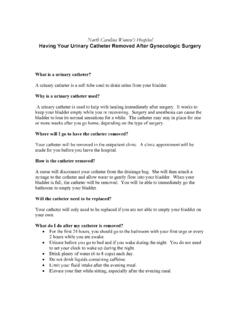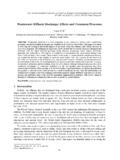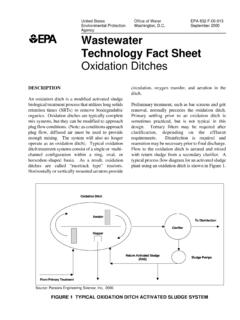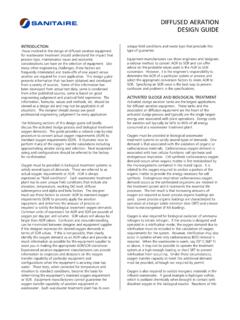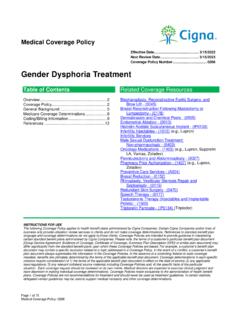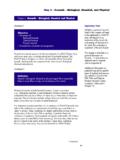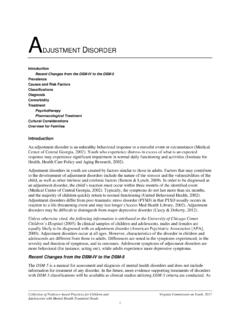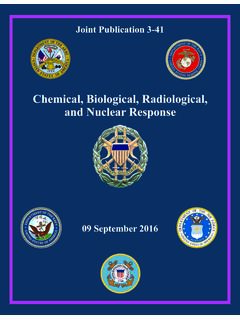Transcription of TREATMENT MANUAL - UNC School of Medicine
1 Edinger, Jack D. 1 TREATMENT MANUAL COGNITIVE-BEHAVIORAL INSOMNIA THERAPY JACK D. EDINGER, VA & DUKE UNIVERSITY MEDICAL CENTERS DURHAM, NC, USA Address: Psychology Service (116B) VA Medical Center 508 Fulton Street. Durham, NC 27705 Email: Edinger, Jack D. 2 PREFACE This TREATMENT MANUAL originally was prepared as an Appendix to our NIMH-funded grant ( MH 48187) entitled, "Cognitive-Behavioral Insomnia for Primary Insomnia" The primary purpose of this MANUAL is to describe and operationalize the cognitive-behavioral therapy (CBT) protocol. However, this MANUAL has been written in such a manner as to provide other investigators and clinicians an understanding of CBT as well as step-by-step instructions for replicating our procedures.
2 Thus, this document should facilitate the "exportation" of our TREATMENT procedures to other investigators and sleep centers. The specific TREATMENT procedures presented herein have been derived form various sources. The cognitive-behavioral therapy (CBT) protocol is based on the writings of Morin (1989) and Spielman (1987) as well as our own research and clinical experience with this TREATMENT . This TREATMENT MANUAL is divided into several sections. Each section provides a " TREATMENT rationale" to be provided to patients undergoing TREATMENT . Specific information and instructions to be provided to patients are highlighted with quotation marks (") and italics.
3 Investigators who wish to replicate our procedures should present the highlighted information and instructions to their patients verbatim. It is also recommended that those who wish to use these treatments in their own insomnia research first review the list of "Suggested Readings provided at the conclusion of each section. Edinger, Jack D. 3 TABLE OF CONTENTS General Rationale 4 Collecting Baseline Data 4 Session by Session Outline 5 Providing Sleep Education 6 Behavioral TREATMENT Regimen 10 Determining Time in Bed Prescriptions 11 Follow-up.
4 Sessions 2 to 6 12 Suggested Readings 15 Sleep Log Appendix Patient Brochure AppendixEdinger, Jack D. 4 COGNITIVE-BEHAVIORAL THERAPY TREATMENT INSTRUCTIONS GENERAL RATIONALE Cognitive-behavioral therapy (CBT) is based largely on Spielman's conceptual model for primary insomnia.
5 According to Spielman, predisposing factors, precipitating events, and perpetuating mechanisms all contribute to the development of chronic primary sleep difficulties. In Spielman's view, some individuals may be particularly predisposed or vulnerable to sleep difficulties by virtue of having a "weak," "highly sensitive," or dysfunctional biological sleep system. When such individuals are confronted with the proper precipitating circumstances ( a stressful life event), they tend to develop an acute sleep disturbance. This sleep problem, in turn, may then be perpetuated if the patient develops poor sleep hygiene practices ( varying sleep-wake schedule, daytime napping, spending excessive time in bed, etc.)
6 In an effort to cope with the sleep difficulty. Thus, although predisposing and precipitating factors contribute to insomnia, poor sleep hygiene is viewed as a critical sustaining element in the sleep disturbance. As a result, our cognitive-behavioral approach is, in part, designed to correct those sleep habits that ostensibly sustain or add to patients' sleep problems. In our use of CBT, we have found it helpful to present the above rationale to patients so that they are more likely to accept and comply with this TREATMENT 's behavioral prescriptions. In the current project the following explanation will be presented at the beginning of first TREATMENT session to each individual undergoing CBT.
7 "We have conducted a thorough evaluation of your sleep problem and, based on our findings, we believe that you will benefit from some information about sleep and some recommendations designed to help you change your sleep habits. When sleep problems linger on, as they have in your case, usually sleep habits develop and add to the sleep problem. The TREATMENT you receive will educate you about your sleep problem and help you correct your bad sleep, habits so that you can again have a more normal sleep pattern." COLLECTING BASELINE DATA Before beginning CBT, it is essential to obtain baseline sleep data.
8 In addition to providing information about the severity of the patient's sleep problem, these data are needed to determine individualized time in bed (TIB) prescriptions for each patient. In the current project, we will use results Edinger, Jack D. 5of sleep log monitoring conducted during a 2-week pre- TREATMENT assessment to obtain these baseline data. A copy of the log form to be used is provided in the appendix of our project proposal. Investigators wishing to replicate our procedures may photocopy the sleep log for use with their patients. SESSION-BY-SESSION OUTLINE Subjects who undergo CBT will be provided TREATMENT in a standard fashion.
9 Presented below is a brief outline that shows the content of the CBT TREATMENT sessions. As shown by this outline, all essential TREATMENT components including the TREATMENT rationale, sleep education, and the behavioral regimen are presented during the first TREATMENT session. Subsequent sessions are devoted to a review of the patient's progress, making alterations in time in bed (TIB) prescriptions, assessing/reinforcing patient compliance, and trouble-shooting patient problems with TREATMENT . Those investigators who wish to replicate our procedures should use this outline to guide their application of CBT. TREATMENT Outline I.
10 Session 1: Primary TREATMENT Components (45 to 60 min.) A. Presentation of TREATMENT Rationale (see page 4 top) B. Sleep Education (see pages 6 to 9) 1. Sleep Norms 2. Circadian Rhythms 3. Effects of Aging on Sleep 4. Sleep Deprivation C. Behavioral Regimen (see pages 11 to 19) D. Instruction on Making Adjustments in Individualized TIB Prescriptions II. Sessions 2 to 4: Review of Progress/Trouble Shooting (30 to 45 min. each) A. Review Sleep Logs/Alter TIB Prescriptions B. Encourage/Reinforce Compliance C. Trouble-shoot Patient's Problems Edinger, Jack D. 6 PROVIDING SLEEP EDUCATION The sleep education provided to patients during CBT has two primary functions.




